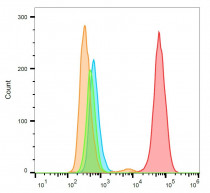ARG53882
anti-CD59 antibody [MEM-43] (PE)
anti-CD59 antibody [MEM-43] (PE) for Flow cytometry and Human
Cell Biology and Cellular Response antibody; Developmental Biology antibody; Immune System antibody; Signaling Transduction antibody
Overview
| Product Description | PE-conjugated Mouse Monoclonal antibody [MEM-43] recognizes CD59 |
|---|---|
| Tested Reactivity | Hu |
| Tested Application | FACS |
| Specificity | The clone MEM-43 reacts with well defined epitope (W40, R-53) on CD59 (Protectin), an 18-20 kDa glycosylphosphatidylinositol (GPI)-anchored glycoprotein expressed on all hematopoietic cells; it is widely present on cells in all tissues. HLDA IV; WS Code NL 705 HLDA V; WS Code AS S013 HLDA V; WS Code BP BP345 HLDA V; WS Code T T-103 |
| Host | Mouse |
| Clonality | Monoclonal |
| Clone | MEM-43 |
| Isotype | IgG2a |
| Target Name | CD59 |
| Immunogen | Thymocytes and T lymphocytes |
| Conjugation | PE |
| Alternate Names | EJ30; MIRL; Membrane attack complex inhibition factor; CD antigen CD59; EJ16; Membrane inhibitor of reactive lysis; MIC11; EL32; HRF20; HRF-20; MEM43 antigen; MIN1; MIN2; MIN3; 1F5 antigen; 1F5; MACIF; MAC-IP; MSK21; Protectin; G344; p18-20; CD59 glycoprotein; MEM43; MAC-inhibitory protein; 16.3A5; 20 kDa homologous restriction factor |
Application Instructions
| Application Suggestion |
|
||||
|---|---|---|---|---|---|
| Application Note | * The dilutions indicate recommended starting dilutions and the optimal dilutions or concentrations should be determined by the scientist. |
Properties
| Form | Liquid |
|---|---|
| Purification Note | The purified antibody is conjugated with R-Phycoerythrin (PE) under optimum conditions. The conjugate is purified by size-exclusion chromatography and adjusted for direct use. No reconstitution is necessary. |
| Buffer | PBS, 15 mM Sodium azide and 0.2% (w/v) high-grade protease free BSA |
| Preservative | 15 mM Sodium azide |
| Stabilizer | 0.2% (w/v) high-grade protease free BSA |
| Storage Instruction | Aliquot and store in the dark at 2-8°C. Keep protected from prolonged exposure to light. Avoid repeated freeze/thaw cycles. Suggest spin the vial prior to opening. The antibody solution should be gently mixed before use. |
| Note | For laboratory research only, not for drug, diagnostic or other use. |
Bioinformation
| Database Links | |
|---|---|
| Gene Symbol | CD59 |
| Gene Full Name | CD59 molecule, complement regulatory protein |
| Background | CD59 (Protectin) is a small (18-20 kDa) GPI-anchored ubiquitously expressed inhibitor of the membrane attack complex (MAC). It is thus the key regulator that preserves the autologous cells from terminal effector mechanism of the complement cascade. CD59 associates with C5b-8 complex and thereby counteracts appropriate formation of cytolytic pore within the plasma membrane. CD59 is also an low-affinity ligand of human CD2 and causes T cell costimulation. |
| Function | Potent inhibitor of the complement membrane attack complex (MAC) action. Acts by binding to the C8 and/or C9 complements of the assembling MAC, thereby preventing incorporation of the multiple copies of C9 required for complete formation of the osmolytic pore. This inhibitor appears to be species-specific. Involved in signal transduction for T-cell activation complexed to a protein tyrosine kinase. The soluble form from urine retains its specific complement binding activity, but exhibits greatly reduced ability to inhibit MAC assembly on cell membranes. [UniProt] |
| Research Area | Cell Biology and Cellular Response antibody; Developmental Biology antibody; Immune System antibody; Signaling Transduction antibody |
| Calculated MW | 14 kDa |
| PTM | N- and O-glycosylated. The N-glycosylation mainly consists of a family of biantennary complex-type structures with and without lactosamine extensions and outer arm fucose residues. Also significant amounts of triantennary complexes (22%). Variable sialylation also present in the Asn-43 oligosaccharide. The predominant O-glycans are mono-sialylated forms of the disaccharide, Gal-beta-1,3GalNAc, and their sites of attachment are probably on Thr-76 and Thr-77. The GPI-anchor of soluble urinary CD59 has no inositol-associated phospholipid, but is composed of seven different GPI-anchor variants of one or more monosaccharide units. Major variants contain sialic acid, mannose and glucosamine. Sialic acid linked to an N-acetylhexosamine-galactose arm is present in two variants. Glycated. Glycation is found in diabetic subjects, but only at minimal levels in nondiabetic subjects. Glycated CD59 lacks MAC-inhibitory function and confers to vascular complications of diabetes. |
Images (2) Click the Picture to Zoom In
-
ARG53882 anti-CD59 antibody [MEM-43] (PE) FACS image
Flow Cytometry: Human peripheral blood cells stained with ARG53882 anti-CD59 antibody [MEM-43] (PE).
-
ARG53882 anti-CD59 antibody [MEM-43] (PE) FACS image
Flow Cytometry: HL-60 (red) and SP2 (blue) cells stained with ARG53882 anti-CD59 antibody [MEM-43] (PE). Blank samples: HL-60 (orange) and SP2 (green).
Clone References









